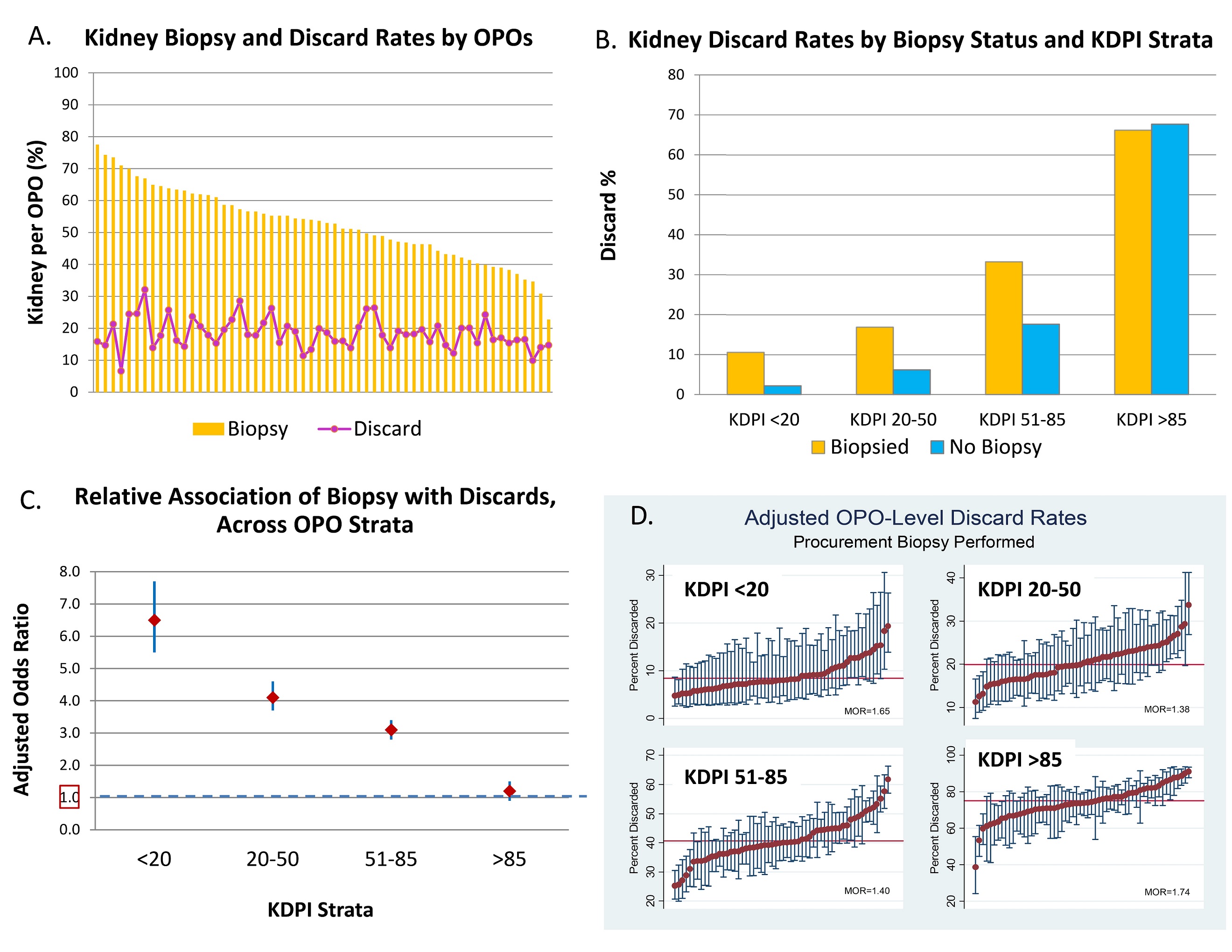Organ-Procurement Organization and Donor Factor-Related Variation in Deceased Donor Kidney Biopsies and Discards: A National Practice Patterns Analysis
1Saint Louis Univ, St. Louis, MO, 2Univ of Michigan, Ann Arbor, MI, 3Washington Univ, St. Louis, MO, 4SRTR, Minneapolis, MN, 5Mid-America Transplant, St. Louis, MO, 6Georgetown Univ, Washington, DC, 7Univ of Iowa, Iowa City, IA
Meeting: 2019 American Transplant Congress
Abstract number: B140
Keywords: Biopsy, Kidney transplantation, Multivariate analysis, Procurement
Session Information
Session Name: Poster Session B: Kidney Donor Selection / Management Issues
Session Type: Poster Session
Date: Sunday, June 2, 2019
Session Time: 6:00pm-7:00pm
 Presentation Time: 6:00pm-7:00pm
Presentation Time: 6:00pm-7:00pm
Location: Hall C & D
*Purpose: The clinical utility and outcome implications of deceased donor kidney allograft procurement biopsies are controversial.
*Methods: We analyzed Scientific Registry of Transplant Recipients data (n=59,328 allografts, 201418) to describe biopsy practices across US organ procurement organizations (OPOs), and examine relationships with discards, using hierarchical modeling to account for OPO and donor factors. Median odds ratios (MOR) provided medians of the odds that allografts with identical reported traits would be biopsied or discarded from 2 randomly drawn OPOs.
*Results: Average biopsy rate was 52.7%, range 22.8%-77.5% across OPOs (Fig A); average discard rate was 18.4%, range 6.6% 32.1%. Biopsy rose in a graded manner with kidney donor profile index (KDPI) (Fig B), but practice varied across OPOs after adjusting for KDPI and other donor factors. Biopsy was associated with discard, most pronounced among low-risk (KDPI <20) kidneys (adjusted odds ratio (95%LCLaOR 95%UCL) 5.456.477.69), with minimal impact at KDPI >85 (Fig C). After adjusting for OPO, likelihood of discard rose in a graded manner with higher KDPI (>85: aOR 10.3111.1812.12) and PHS Increased risk/hepatitis C seropositivity KDPI (>85: aOR 4.084.535.03). Variation in discards differed by biopsy status, with less variability for biopsied vs non-biopsied kidneys at KDPIs >20 (MOR: KDPI 20-50: 1.38 vs 1.46; KDPI 51-85: 1.40 vs 1.65; KDPI >85: 1.74 vs 1.98) (Fig D). At low KDPI, discards varied more when a biopsy was done.
*Conclusions: Kidney allograft procurement biopsy and discard practices varied considerably across OPOs. Biopsy correlated with discards; the relationship was complex and strongest for low-risk organs. More evidence is needed to inform standards for biopsy performance, and use and application of biopsy results.
To cite this abstract in AMA style:
Lentine K, Naik A, Schnitzler M, Randall H, Wellen J, Kasiske B, Marklin G, Brockmeier D, Cooper M, Xiao H, Zhang Z, Gaston R, Rothweiler R, Axelrod D. Organ-Procurement Organization and Donor Factor-Related Variation in Deceased Donor Kidney Biopsies and Discards: A National Practice Patterns Analysis [abstract]. Am J Transplant. 2019; 19 (suppl 3). https://atcmeetingabstracts.com/abstract/organ-procurement-organization-and-donor-factor-related-variation-in-deceased-donor-kidney-biopsies-and-discards-a-national-practice-patterns-analysis/. Accessed December 15, 2025.« Back to 2019 American Transplant Congress

